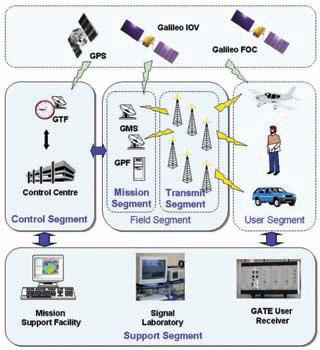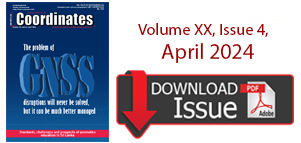
Ground segment of GAGAN i.e. Indian Reference Station (INRES) at Delhi, Kolkatta, Guwahati, Portblair, Ahmedabad, Banglore, Jammu and Trivanthapuram is in place. Except Portblair, other stations have been connected to Indian Master Control Center (INMCC) with fiber optic cable in synchronous loop mode. Portblair is connected through dedicated satellite communication network. Its integration and connectivity test with seven INRES with INMCC have been completed. The INRES data is being received through fiber optic cable at INMCC Banglore for corrections and validation checks of the erroneous data. Preliminary Site Acceptance Test (PSAT) of GAGAN ground element was conducted in May 2006 with help of satellite emulator.

Navigational regionalism
Global Navigational Systems could have served the globe.
However, regions have specific needs.
Moreover, aspirations.
Aspirations to own and control the technology.
Owning makes sense as it adds to the might.
The desire and importance of ‘being mighty’ cannot be undermined.
So the pace for regionalism in navigation system may increase.
Still, they may work in cooperation. Hopefully.
…

GATE is a ground-based realistic test environment for developers of receivers, applications and services for the future satellite navigation system Galileo. GATE is currently being builtup and as from beginning of 2008 – several years before Galileo becomes fully operational – Galileo signals will be emitted by 6 earth-fixed transmitters in the area of Berchtesgaden, located in the southeast of Germany in the German Alps. This will provide the opportunity for receiver, application and service developers to perform realistic field-tests of hardware and software for Galileo at an early stage. In this way GATE will also support German and European products for Galileo entering the market.
While the motivation of the US groundbased ranging test bed Yuma in the 70’s was to prove the concept of satellite navigation, no one doubts that Galileo will work from a conceptual point of view. However, it is still an ambitious technological project, introducing a signal structure far more sophisticated than the GPS C/A Code. In fact there are three major mission objectives to be covered by GATE – Signal Experiments, Receiver Testing and User applications.

Norwegian Prime Minister opens new Antarctic satellite station
“The Norwegian satellite station TrollSat is a milestone in satellite surveillance of the environment”, Prime Minister Jens Stoltenberg said. It offers better and quicker access to vital climate, environment and weather data. The data will be used in research and in other environment surveillance. He also laid the foundation stone for the Galileo station next to TrollSat. The station will be ready in 2009. The Galileo station in the Antarctic will be part of the European navigation system Galileo, which will be operational in 2013 and be based on space satellites. www.norwaypost.no

Indo-Norwegian pact on developing TOPAZ
WAn Indo-Norwegian agreement was signed to collaborate in developing an operational ocean modelling and data assimilation system for the Indian Ocean—the TOPAZ Indian Ocean forecasting system. The parties from Norway are the Nansen Environmental and Remote Sensing Centre (NERSC) and the University of Bergen (UoB), while the Indian National Centre for Ocean Information Services (INCOIS) and Nansen Environmental Research Centre-India (NERCI) Kochi are from India. According to a press release issued here, the TOPAZ Indian Ocean system has been implemented, assessed and used by a group of scientists of Bergen and Kochi. www.hindu.com

Chinese vice-premier urges scientific outlook
Chinese Vice-Premier Zeng Peiyan has urged authorities responsible for statistics, surveying and mapping, food and tobacco to implement the government’s scientific outlook on development and innovate to improve accuracy and authority. Related authorities should improve their surveying and mapping work to provide a quality service for the country’s construction, he said. http://news.xinhuanet.com

Topcon GNSS first to add China’s Compass signal
Topcon Positioning Systems (TPS) is the first to announce to have successfully tracked signals from the Chinese Compass satellite constellation. It also developed the world’s first GNSS technology to pick up signals from GPS, GLONASS, the planned Galileo satellite system.

Edited by Abbas Rajabifard
ISBN 978-0-7325-1620-8
Published by Centre for SDIs and Land Administration,
Department of Geomatics,
The University of Melbourne
Towards a Spatially Enabled Society
‘Spatially enabled government’, ‘spatially enabled society’, ‘spatially enabled’…… These are terms which we are hearing more and more of these days. A society or a government can be …

RECENTadvances in information and communication technology (ICT)
have resulted in a changing environment with many interdependencies between organizations. There are various data services produced and consumed within the process of enhancement of pipelines project. This happens along the various phases; feasibility study, land allocation, execution and operation. Problems in data sharing arise from the fact that data services are not properly documented resulting in difficulties in updating data, data duplication and long administrative inter–organisational procedures[1]. This article presents a method for elaborating the trade-off between existing situation and the desired future in case of improving conditional data sharing.

This mega thrust earthquake of Dec 26, 2004 shifted several sites on Indian and Eurasian plates, which has been quantified from various GPS studies. As the relative change in triangular area between different sites is more sensitive than the relative change in their coordinates, it has been attempted to calculate the anomalies in triangular area on daily basis between 12 permanent GPS stations of C-MMACS and 16 IGS stations for a period of 60 days from 1st Dec 2004 – 30th Jan 2005.







 (5.00 out of 5)
(5.00 out of 5)